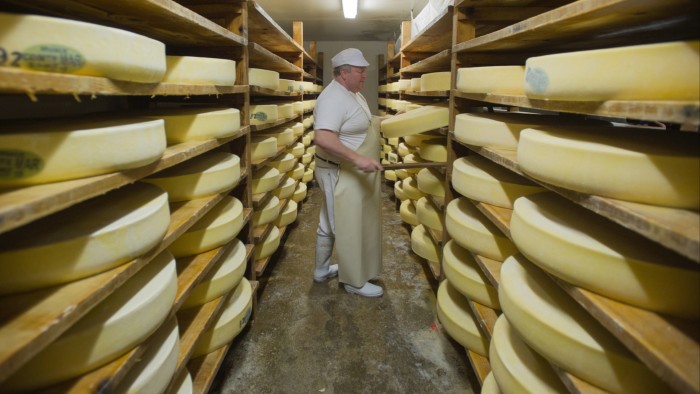Unlock the Editor’s Digest for free
Roula Khalaf, Editor of the FT, selects her favourite stories in this weekly newsletter.
At my local fromagerie, nutty wedges of 24-month-aged comté stand, quite literally, on a pedestal.
The cheesemonger has placed France’s favourite cheese on a table in the middle of her store, raised on a platform. Pale, golden doorstoppers, priced at €49.90 per kilo, look down on all the other cuts.
Comté is France’s most sold cheese with an appellation d’origine protégée (AOP) — an EU-backed status that ensures it comes from a specific region, or terroir. In 2023, French people bought 32,000 tonnes of the stuff, almost 500g per person. Those surprised by this should try some. It’s delicious.
But France’s appetite is turning into a problem. This year, the country has been gripped by an argument over comté’s heavy environmental footprint.
In late April, environmentalist Pierre Rigaux took to France Inter radio station and criticised the intensification of cheese production in Franche-Comté, the mountainous eastern French region where comté is made. Production has led to pollution of rivers from fertilisers and a rapid drop in fish life and biodiversity, he said.
“The subject is known locally,” he says. “But much less at the national level, apparently.”
The comments went largely unnoticed at the time. But a few weeks later a Figaro magazine piece attacked Rigaux and his kind as “khmers verts” [green terrorists]. Rightwing politicians called his criticism “an attack on our way of life”.
France’s green party has attempted to distance itself from the fight, saying that it “loves” comté but wants to ensure high quality environmental standards. Green party leader Marine Tondelier was pictured next to a plate of comté to reinforce her cheese-loving credentials.
Rigaux, an animal rights activist, tells me he was bemused by the reaction. “I never called for anything to be banned, which would be absurd,” he said. “I prefer to be clear; when you eat cheese, you’re killing animals and polluting rivers. It’s factual . . . everyone is free [to make their choice].”
All cheese consumption has an environmental impact. But comté — a hard cheese that must be pressed — requires more cow’s milk than softer cheeses, meaning its production involves more methane. Consumption has also doubled in 30 years.
While excess cheese consumption is far from the greatest environmental challenge facing France, the comté fight points to the challenges for terroir produce to keep up with mass consumption.
Comté farmers protest that their production is no more intensive than cheese made elsewhere, and respects strict standards. But dairy farming in Franche-Comté is particularly damaging.
The mountainous territory has a “karst” geology. Its landscape is formed from soil that is not very deep and limestone rock is more porous than other land forms, explains François Degiorgi, a scientist at the university of Franche-Comté.
“There are no holes in comté but there are holes in the ground,” he says. Excess fertilisers make their way easily into rivers.
As a result, fish populations in the Jura have plummeted. A 2020 study by Degiorgi and other academics found that salmon had dropped by 50 to 80 per cent in the local Loue river since the 1960s. Amid the barrage of abuse, Rigaux says that he received support from fishers.
Rigaux has stopped eating comté. But Degiorgi — a self-confessed fan — describes the debate as “sterile”, noting that comté is far from the only pollutant in the region.
The furore has highlighted an increasing political pushback to environmental measures in France. Last month, rightwing parties unsuccessfully sought to place a moratorium on new wind and solar plants.
It also points to consumer unwillingness to change their personal habits for the sake of the environment. Strictly for research purposes, I picked up 200g of 18-month-old comté at the Fromagerie de Montmartre. The cheesemonger dismisses any chance of a drop in demand as a result of the controversy. Shrugging her shoulders, she says, “It’s still our most sold.”
